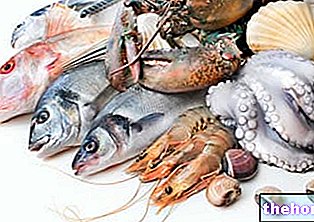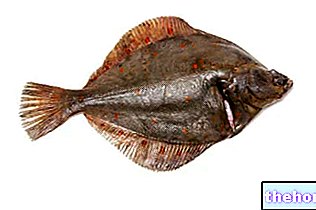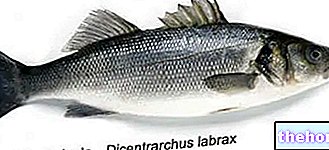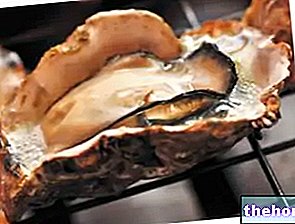What are Seafood
The term seafood refers to a group of foods of animal origin, often of salt water (but it is not said!), Which groups together the organisms belonging to the line of molluscs and to that of crustaceans.

Seafood - clams: cephalopods (provided with internal shell or without shell, for example octopus, cuttlefish, squid, baby octopus, squid, octopus, etc.); gastropods (univalve or with external shell, for example snails, snails, limpets, sea ears, etc.); lamellibranchs (bivalves therefore with external shells, for example mussels (mussels), clams, cockles, clams, razor clams, scallops, canestrelli, sea truffles, dates of the sea, oysters, pinna nobilis, etc).
Seafood - crustaceans: macruri (long, distended abdomen with fan-shaped tail fin, for example lobster, lobster, shrimp, Norway lobster, etc.); brachiuri (short abdomen without fan, folded under the capothorax, for example the crab or spider crab); stomatopods (provided with two buccal appendages with attached "kidnapping" claws formed by a mobile toothed article that folds over the segment itself (eg mantis shrimp, corbola, etc.).
Nutritional properties
In order to describe the nutritional properties of seafood, it would be advisable to treat the various animal species individually or, at least, the various classification groups; however, by virtue of the heterogeneity typical of seafood preparations, the reader will benefit more from a general and less thorough description of the subject. Below, ONLY the two strands will be analyzed separately, namely molluscs and crustaceans.
The caloric content of shellfish is generally low or moderate; among cephalopods, gastropods and lamellibranchs, the nutritionally richest ones are certainly gastropods (snails, limpets, abalone, snails, etc.), albeit less consumed and generally considered "obsolete" foods. They boast an energy and protein intake higher than the other two (about 100kcal for 100g and over 17g of protein, against 60-75 kcal and 10-14g of protein), which are widely used in low-calorie diets. We also remember that ALL molluscs (and especially cephalopods) contain an extremely reduced lipid portion consisting mainly of polyunsaturated fatty acids; on the other hand, bivalves (especially mussels and oysters) are distinguished by a notable contribution of cholesterol, an extremely limiting feature when related to cholesterol-lowering diets.
The molluscs also provide good vitamin quantities of cobalamin (vitamin B12) and, in a variable manner, of the other vitamins of the B complex. They are also distinguished by a significant contribution of iron (Fe) emic, iodine (I), zinc (Zn) and selenium (Se). In any case, it is advisable to pay attention to the sodium (Na) intake, as both bivalve molluscs and gastropods bring sufficient quantities to make them unsuitable for the dietary treatment of arterial hypertension.
It is not possible to uniquely describe the digestibility of molluscs, as it varies significantly from one group to another, from one species to another and, above all, from one culinary preparation to another. bivalves.
Analyzing the nutritional content of crustaceans in seafood, first of all it should be specified that they are ALWAYS foods with a high cholesterol intake, therefore, as for some molluscs, their use is NOT frequently applied in diets aimed at controlling the " hypercholesterolemia. On the other hand, crustaceans boast a moderate lipid content and characterized by the prevalence of omega3 essential fatty acids compared to omega6, an undoubtedly appreciable characteristic. From an energy point of view, they rarely exceed 70-80 kcal for 100g of edible part, while the protein intake is good and is between 13 and 18g (the carbohydrate content is negligible).
Even crustaceans in the preparation of seafood, like some molluscs (see above), contain a considerable amount of dietary sodium and in a similar way are not indicated in hypotensive diets. However, they provide excellent amounts of hemi iron and calcium (Ca), but with a reduced content of phosphorus (P), a mineral which in high doses becomes responsible for impairing intestinal calcium absorption. The content of B vitamins it can be superimposed on that of meat and fish.
Consumption frequencies
From what emerged in the previous paragraphs, the "suitability for consumption of seafood depends exclusively on the presence of an adequate clinical picture. Hypertension and hypercholesterolemia are pathologies that make it difficult to include seafood in the diet, except for some of them. they (cephalopod molluscs); therefore, in these cases, its use is generally NOT RECOMMENDED (by some admitted occasionally and in limited quantities). At the same time, in the absence of metabolic alterations, the consumption of seafood could be useful in reducing the consumption of meat, eggs and cheeses, BUT it must not in any way replace the consumption of fish proper.
In a balanced diet, the consumption of seafood is hardly part of the weekly menu and in my opinion they could be used correctly lump sum (1:10 or 1:15 days). In the event that they are part of the subject's eating habits, it would be desirable to prefer the varieties with lower cholesterol and lower sodium content, as well as, if necessary, eliminate the cooking water of the food with the aim of drastically reducing the TYPICAL residual sodium intake of seafood-based preparations.
Bibliography:
- The edible animals of the seas of Italy - A. Palombi, M. Santarelli - page 364
- Food composition tables - INRAN (National Research Institute of Food and Nutrition)
- Food microbiology - J. M. Jay, M. J. Loaessner, D. A. Golden - Springer - 126-127




























